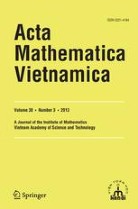
Acta Mathematica Vietnamica
- Volume 50
- Volume 49
- Volume 48
- Volume 47
- Volume 46
- Volume 45
- Volume 44
- Volume 43
- Volume 42
- Volume 41
- Volume 40
- Volume 39
- Volume 38
- Volume 37
- Volume 36
- Volume 35
- Volume 34
- Volume 33
- Volume 32
- Volume 31
- Volume 30
- Volume 29
- Volume 28
- Volume 27
- Volume 26
- Volume 25
- Volume 24
- Volume 23
- Volume 22
- Volume 21
- Volume 20
- Volume 19
- Volume 18
- Volume 17
- Volume 16
- Volume 15
- Volume 14
- Volume 13
- Volume 12
- Volume 11
- Volume 10
- Volume 9
- Volume 8
- Volume 7
- Volume 6
- Volume 5
- Volume 4
- Volume 3
- Volume 2
- Volume 1
The Lagrange reduction of the N-body problem, a survey
Alain Chenciner
Abstract
In his fundamental “Essai sur le problème des trois corps” (Oeuvres, vol. 6, pp. 229–324, 1772), Lagrange, well before Jacobi’s “reduction of the node”, carries out the first complete reduction of symmetries in this problem. Discovering the so-called homographic motions (Euler had treated only the collinear case), he shows that these motions necessarily take place in a fixed plane, a result which is simple only for the “relative equilibria”. In order to understand the true nature of this reduction—and of Lagrange’s equations—it is necessary to consider the n-body problem in an euclidean space of arbitrary dimension. The actual dimension of the ambient space then appears as a constraint, namely the angular momentum bivector’s degeneracy. I describe in detail the results obtained in a joint paper with Alain Albouy published in French in 1998 (Albouy and Chenciner in Invent. Math. 131:151–184, 1998): for a non-homothetic homographic motion to exist, it is necessary that the motion takes place in an even-dimensional space. Two cases are possible: either the configuration is “central” (that is, we have a critical point of the potential among configurations with a given moment of inertia) and the space where the motion takes place is endowed with a hermitian structure, or it is “balanced” (that is, we have a critical point of the potential among configurations with a given inertia spectrum) and the motion is a new type, quasi-periodic, of relative equilibrium. Only the first type is of Kepler type and hence corresponds to the absolute minimum in Sundman’s inequality. When the space of motion is odd-dimensional, one can look for a substitute to the non-existing homographic motions: a candidate is the family of Hip-Hop solutions, which are “simple” periodic solutions naturally related to relative equilibria through Lyapunov families of quasi-periodic solutions (see Chenciner and Féjoz in Regul. Chaotic Dyn. 14(1):64–115, 2009). Finally, some words are said on the bifurcation of periodic central relative equilibria to quasi-periodic balanced ones.


